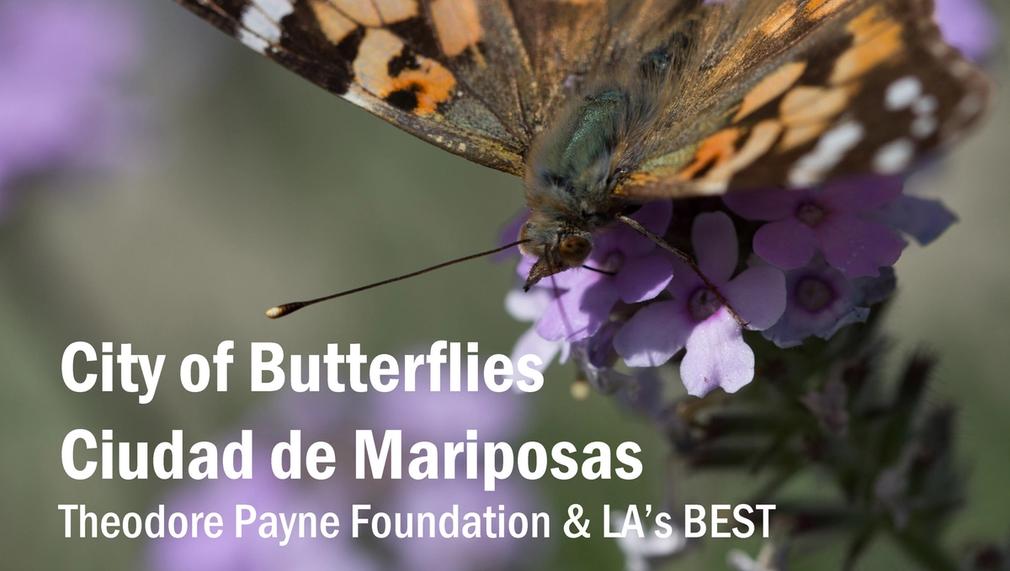City of Butterflies / Cuidad de Mariposas
City of Butterflies / Cuidad de Mariposas empowers children to become environmental stewards who make their communities safer, more life sustaining, and playful by planting butterfly gardens to enjoy with their families and neighbors. Youth will develop a relationship with the natural world while learning how native California plants support butterflies and activate vacant space with color, fragrance, and life.

Please list the organizations collaborating on this proposal.
LA’s BEST Afterschool Enrichment Program
Briefly tell us a story that demonstrates how your organization turns inspiration into impact.
Ella was in middle school when she heard a Theodore Payne outreach talk about the habitat value of native plants. Moved by the power of plants to support pollinators, Ella got permission from her principal to turn a neglected corner into a butterfly garden. She researched the appropriate plants, prepared the site, raised a little money, and then dug her first hole. One year later, Ella had created a thriving native plant garden, complete with signs identifying the plants their butterfly visitors. More than that, she’d recruited fellow students to help care for the garden so when Ella moved on to high school — where she started a new native plant garden — her original project was left in good hands. All along, Ella got advice and inspiration from Theodore Payne Foundation staff. We were more than proud to sponsor her attendance at a native plant conference. Today, Ella is applying to colleges for a biology degree so she can continue to steward nature through her career.
Which of the PLAY metrics will your submission impact?
Access to open space and park facilities
Number (and quality) of informal spaces for play
Number of children enrolled in afterschool programs
In which areas of Los Angeles will you be directly working?
County of Los Angeles
How will your project make LA the best place to PLAY?
Let’s face it: Los Angeles is notoriously park poor. While there are many worthy efforts to create more parks, including the recently passed Measure A, these projects may take years before they are open for play and even longer before play spaces are equitably placed around the city. In the meantime, even a couple of native plants will attract butterflies that are looking for a meal and a place to lay their eggs providing children a reason to spend time outdoors, immersing themselves in a world of senses, and sharing their observations with others.
CoB/CdM will be offered to children and families taking part in the LA’s BEST club-based activities, family outreach events, and on field trips that connect participants to the environment and cultivate a culture of civic engagement and environmental activism.
Participating households will each receive:
* Instruction on how to care for the plants and identify the caterpillars and butterflies that are sure to visit them.
* A bilingual booklet illustrating the plant/butterfly connection, life cycle of butterflies, growing cycle of plants, how to plant and care for nectar and forage plants, and space to record observations
* Four 4” plants that will grow to be 3’ or under to fit into smaller spaces or in containers. Forage plants for caterpillars will be paired with nectar plants for butterflies.
* Information on how to register their garden on the Million Pollinator Network so they take their place in a national movement to support nature
Population served: Eighty-one percent (81%) of children served by LA’s BEST are Latino, 12% are African American, 3% are Asian, and 3% are Caucasian. For 44% of students served by LA's BEST, English is a second language. Fifty-one percent (51%) of participants are female, and 49% are male. On average, 90% of LA’s BEST students qualify for free or reduced-price lunch.
Timeline:
2019 summer — program finalized, plants grown, LA’s BEST summer program offered; fall — clubs, outreach, and field trips programs offered, all plants in ground by end of 2019
2020 winter — monitor progress, spring — report data and evaluate
Progress: By planting in small spaces around the city — parkways, allies, dooryard gardens, and balconies — children will activate vacant spaces and increase the number of engaging play outdoor places by 1,000-2,500. The plants involved are “city-sized” so they will thrive in the smaller planting spaces, especially those found around many multi-family housing units that lack more developed play spaces. These newly activated spaces will be easily accessible to children and their families as they will be adjacent to their homes or augments to afterschool gardens. City of Butterflies expands the environmental curriculum for LA’s BEST, giving even more families a reason to enroll their children in the afterschool program.
In what stage of innovation is this project?
Pilot project (testing a new idea on a small scale to prove feasibility)
Please explain how you will define and measure success for your project.
Outputs: 2,500 children and 5,000 family members reached with programming; 10,000 plants distributed
Outcomes: 1,000-2,500 new play spaces created; 500 children reporting on their plants and butterflies; 15,000 butterflies hatched; 25,000 children will be enrolled in the LA’s BEST Afterschool Enrichment Program